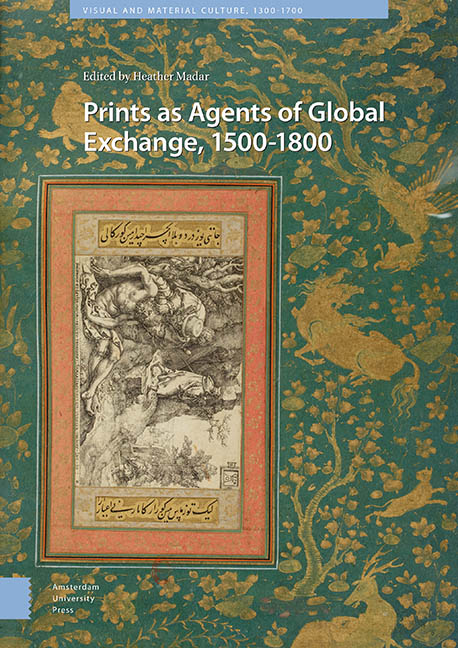Book contents
- Frontmatter
- Table of Contents
- List of illustrations
- Introduction
- 1 Concealing and Revealing the Female Body in European Prints and Mughal Paintings
- 2 The Sultan’s Face Looks East and West: European Prints and Ottoman Sultan Portraiture
- 3 From Europe to Persia and Back Again: Border-Crossing Prints and the Asymmetries of Early Modern Cultural Encounter
- 4 The Dissemination of Western European Prints Eastward: The Armenian Case
- 5 The Catholic Reformation and Japanese Hidden Christians: Books as Historical Ties
- 6 (Re)framing the Virgin of Guadalupe: The Concurrence of Early Modern Prints and Colonial Devotions in Creating the Virgin
- 7 Hidden Resemblances: Re-contextualized and Re-framed: Diego de Valadés’ Cross Cultural Exchange
- 8 The Practice of Art: Auxiliary Plastic Models and Prints in Italy, Spain, and Peru
- 9 Ink and Feathers: Prints, Printed Books, and Mexican Featherwork
- Index
4 - The Dissemination of Western European Prints Eastward: The Armenian Case
Published online by Cambridge University Press: 16 December 2021
- Frontmatter
- Table of Contents
- List of illustrations
- Introduction
- 1 Concealing and Revealing the Female Body in European Prints and Mughal Paintings
- 2 The Sultan’s Face Looks East and West: European Prints and Ottoman Sultan Portraiture
- 3 From Europe to Persia and Back Again: Border-Crossing Prints and the Asymmetries of Early Modern Cultural Encounter
- 4 The Dissemination of Western European Prints Eastward: The Armenian Case
- 5 The Catholic Reformation and Japanese Hidden Christians: Books as Historical Ties
- 6 (Re)framing the Virgin of Guadalupe: The Concurrence of Early Modern Prints and Colonial Devotions in Creating the Virgin
- 7 Hidden Resemblances: Re-contextualized and Re-framed: Diego de Valadés’ Cross Cultural Exchange
- 8 The Practice of Art: Auxiliary Plastic Models and Prints in Italy, Spain, and Peru
- 9 Ink and Feathers: Prints, Printed Books, and Mexican Featherwork
- Index
Summary
Abstract
This article demonstrates how Dutch prints were used as models by Armenian artists in the Near East in the seventeenth and eighteenth centuries. The images were transported to the region through illustrated, printed books in European languages and Armenian. A notable example is the first Bible printed in the Armenian language (Amsterdam, 1666) decorated with woodcuts by Christoffel van Sichem. Armenian printers in Amsterdam acquired the van Sichem woodblocks, reusing them for over a century even when the presses moved to new locales as far as Constantinople. These popular compositions were even recut into new woodblocks by Armenian artists in Constantinople, and thus these images were replicated until the nineteenth century. New Christian iconography was thereby disseminated throughout the region.
Keywords: woodcuts; printing; printed books; Amsterdam; Constantinople; Christoffel van Sichem
Introduction
The history of printing in the Armenian language is complicated and somewhat convoluted, but it began in Europe, as is the case with printing in many other Near Eastern languages. (Greek, Hebrew, Arabic, and Syriac were all first printed in various cities in Italy between the late-fifteenth and early-sixteenth centuries). One of the main reasons for this European origin is that the technology of printing, a European invention, was not yet available in the Near East. As this new technology became more widely accessible, there was certainly opposition from the scribal community, who well realized the threat it posed to their livelihood. In addition, printing was looked upon with suspicion by Muslim rulers, and early attempts to print in the Near East were often thwarted by the authorities. In fact, printing in the Turkish language was not officially permitted in the Ottoman Empire until 1727.
The impetus for Armenians’ interest in printing was a long-standing desire to print the Bible in the Armenian language, a goal stimulated, in part, by exposure to Western European religious printed books transported to the Near East through trade and Catholic missionaries. However, printing the Bible was a huge, expensive project and the earliest Armenian printers began by printing more modest works. The first book printed in the Armenian language, the Urbat’agirk’ (Book of Friday) was produced in Venice in 1511 or 1512 by a mysterious printer known only as Yakob Meghapart, or Jacob the Sinful.
- Type
- Chapter
- Information
- Prints as Agents of Global Exchange1500-1800, pp. 127 - 158Publisher: Amsterdam University PressPrint publication year: 2021



